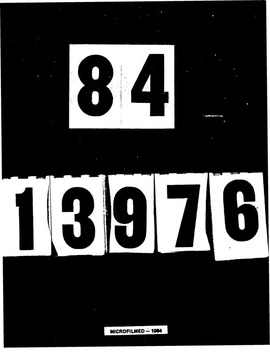| dc.contributor.author | Huff, John Larry, | en_US |
| dc.date.accessioned | 2013-08-16T12:29:01Z | |
| dc.date.available | 2013-08-16T12:29:01Z | |
| dc.date.issued | 1984 | en_US |
| dc.identifier.uri | https://hdl.handle.net/11244/5208 | |
| dc.description.abstract | The results of testing the first null hypothesis led to the general conclusion that there was no real difference between the amount of time the disruptive and non-disruptive students spend watching television. A common belief is that disruptive students watch considerably more television than non-disruptive students but the results of this study would not support this idea. | en_US |
| dc.description.abstract | Results of testing the fourth null hypothesis led to the general conclusion that those disruptive students who viewed the most violent acts on television tended to cause the most classroom disruptions. | en_US |
| dc.description.abstract | The results of testing the third null hypothesis led to the conclusion that those disruptive students who watched the most television saw the most violent acts. | en_US |
| dc.description.abstract | The results of testing the second null hypothesis led to the general conclusion that the disruptive students watched television that was much more violence oriented than the television viewed by the non-disruptive students. | en_US |
| dc.description.abstract | Results of testing the fifth null hypothesis led to the general conclusion that those disruptive students who viewed the most violent acts tended to commit the most serious classroom disruptions. | en_US |
| dc.description.abstract | The purpose of this study was to determine the differences between the television viewing habits of disruptive and non-disruptive students. Two groups of students, disruptive students (N = 32) and non-disruptive studens (N = 50), reported the number of hours they viewed particular television programs aired during a particular one-week period. The number of hours spent viewing television and the number of violent acts viewed were compared for the disruptive students and the non-disruptive students to test two major hypotheses. Three other hypotheses were tested concerning the inter-relationships among the variables measured on the disruptive students. | en_US |
| dc.format.extent | vi, 102 leaves ; | en_US |
| dc.subject | Education, Secondary. | en_US |
| dc.title | A comparison of the television viewing habits and classroom behavior of disruptive and non-disruptive students / | en_US |
| dc.type | Thesis | en_US |
| dc.thesis.degree | Educat.D. | en_US |
| dc.thesis.degreeDiscipline | Jeannine Rainbolt College of Education | en_US |
| dc.note | Source: Dissertation Abstracts International, Volume: 45-03, Section: A, page: 0802. | en_US |
| ou.identifier | (UMI)AAI8413976 | en_US |
| ou.group | Jeannine Rainbolt College of Education | |
